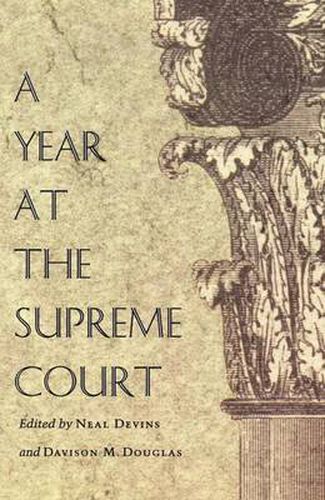Readings Newsletter
Become a Readings Member to make your shopping experience even easier.
Sign in or sign up for free!
You’re not far away from qualifying for FREE standard shipping within Australia
You’ve qualified for FREE standard shipping within Australia
The cart is loading…






The United States Supreme Court’s 2002-03 term confounded Court watchers. The same Rhenquist Court that many had seen as solidly conservative and unduly activist - the Court that had decided the 2000 presidential election and struck down 31 federal statutes since 1995 - issued a set of surprising, watershed rulings. In a term filled with important and unpredictable decisions, it upheld affirmative action, invalidated a same-sex sodomy statute, and reversed a death sentence due to ineffective assistance of counsel. With essays focused on individual Justices, Court practices, and some of last year’s most important rulings, this volume explores the meaning and significance of the Court’s 2002-03 term. Seasoned Supreme Court advocates and journalists from The New York Times, The New Republic, The Los Angeles Times, the National Journal, Slate, Legal Times, and Newsweek grapple with questions about the Rehnquist Court’s identity and the Supreme Court’s role in the political life of the country. Some essays consider the role of swing Justices Sandra Day O'Connor and Anthony Kennedy within a Court that divides 5-4 more than any other group of Justices in the nation’s history. Others examine the political reaction to and legal context of the Court’s Lawrence v. Texas decision declaring a Texas law criminalizing homosexual sodomy unconstitutional. Contributors analyze the Court’s rulings on affirmative action and reassess its commitment to states’ rights. Considering the Court’s practices, one essayist explores the use and utility of amicus curae, or friend of the court briefs, while another reflects on indications of an increased openness by the Court to public scrutiny. Two advocates who argued cases before the Court last year - one related to hate speech and the other to a three strikes and you’re out criminal statute - offer vivid accounts of their experiences. Intended for general readers, A Year at the Supreme Court is for all those who want to understand the Rehnquist Court and its momentous 2002-03 term.
$9.00 standard shipping within Australia
FREE standard shipping within Australia for orders over $100.00
Express & International shipping calculated at checkout
The United States Supreme Court’s 2002-03 term confounded Court watchers. The same Rhenquist Court that many had seen as solidly conservative and unduly activist - the Court that had decided the 2000 presidential election and struck down 31 federal statutes since 1995 - issued a set of surprising, watershed rulings. In a term filled with important and unpredictable decisions, it upheld affirmative action, invalidated a same-sex sodomy statute, and reversed a death sentence due to ineffective assistance of counsel. With essays focused on individual Justices, Court practices, and some of last year’s most important rulings, this volume explores the meaning and significance of the Court’s 2002-03 term. Seasoned Supreme Court advocates and journalists from The New York Times, The New Republic, The Los Angeles Times, the National Journal, Slate, Legal Times, and Newsweek grapple with questions about the Rehnquist Court’s identity and the Supreme Court’s role in the political life of the country. Some essays consider the role of swing Justices Sandra Day O'Connor and Anthony Kennedy within a Court that divides 5-4 more than any other group of Justices in the nation’s history. Others examine the political reaction to and legal context of the Court’s Lawrence v. Texas decision declaring a Texas law criminalizing homosexual sodomy unconstitutional. Contributors analyze the Court’s rulings on affirmative action and reassess its commitment to states’ rights. Considering the Court’s practices, one essayist explores the use and utility of amicus curae, or friend of the court briefs, while another reflects on indications of an increased openness by the Court to public scrutiny. Two advocates who argued cases before the Court last year - one related to hate speech and the other to a three strikes and you’re out criminal statute - offer vivid accounts of their experiences. Intended for general readers, A Year at the Supreme Court is for all those who want to understand the Rehnquist Court and its momentous 2002-03 term.